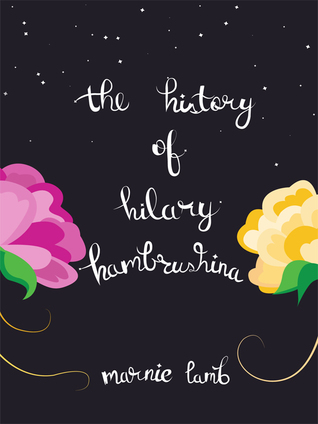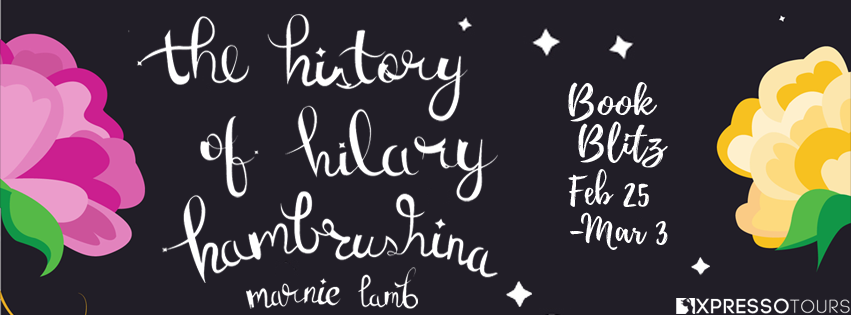
The History of Hilary Hambrushina
Marnie Lamb
Publication date: May 31st 2017
Genres: Contemporary, Young Adult
Hilary has one goal for her first year in junior high: to become popular. But her plans are turned upside down when her best friend leaves for the summer and a quirky girl named Kallie moves in next door. Kallie paints constellations on her ceiling, sleeps in a hammock, and enacts fantastical plays in front of cute boys on the beach. Yet despite Kallie’s lack of interest in being -cool, – Hilary and Kallie find themselves becoming friends. That summer friendship, however, is put to the test when school begins, reigniting Hilary’s obsession with climbing the social ladder. As Hilary discovers the dark side to popularity, she must decide who she wants to be before she loses everything.
Goodreads / Amazon / Barnes & Noble / iBooks / Kobo
EXCERPT
I put on a sweatband and sneakers and brought down a water bottle. My plan was to pedal non-stop for an hour. I figured I could do it, since I was used to riding my own bike, and how different could this bike be? I should lose at least one pound that way, I told myself. So if I use the bike every day, in fifteen days I’ll have lost the weight I want to lose.
I stepped over boxes and piles of books to reach the bike, which sat in a dark corner. This corner had a musty smell, like an old church that hadn’t been dusted since Queen Victoria was my age. A fake raccoon-fur hat someone had given my dad as a joke hung on the wall nearby.
The bike seat was too high for me, but I couldn’t move it because it was screwed in place. Gripping the handlebars for support, I tried to heave my leg over the seat several times without success. I was becoming angry and sweaty, so I started breathing deeply, like I was having a baby, to calm myself down. “Hoo hoo hoo.”
“Hilary!” shouted my mom. “Why are you making monkey noises?”
I froze. I knew that if I said, “It’s nothing,” she’d come down, and I didn’t want her to think I needed help getting on a stationary bicycle. So I called, “I’m just playing a game.”
I managed to lift myself on to the bike. I had to stretch to reach the pedals, but I finally did and started pumping. It was O.K. at first, but soon, my muscles felt like some psycho was using them as rubber bands. And some people actually do this for fun! What’s wrong with them, I thought. I reached for the water bottle and tried to squirt some water in my mouth. Nothing but air came out. I’d forgotten to fill the bottle! I threw it away and continued to pump furiously. Objects on the wall began rattling, and I was making so many strange noises my mother must have thought a whole pack of monkeys was performing a conga line in the basement. I began to have visions of monkeys in spangly pink bikinis
kicking up their heels (did monkeys have heels, I wondered) on stage at the Princess of Wales Theatre.
Suddenly my sweatband fell over my eyes. I didn’t stop to fix it, though. You’re going to pump for the full hour, not for fifty-nine minutes, I ordered myself. Instead, I tried nodding vigorously to get the sweatband to fall under my chin. It fell over my nose and I couldn’t breathe. Then something dark and furry leapt on my head, covering my eyes and tickling my face like a bunch of feathers. I screamed, batting at the thing with one hand and pumping frantically, as if I could escape that way. I soon realized it was only my dad’s hat, but I still couldn’t get it off. Finally I stumbled off the bike and yanked the hat’s tail away from my eyes.
I had no energy left to remove the hat, so I left it on and trudged upstairs. I passed my mom, who took one look at me and started to snicker. Ignoring her, I went into the kitchen to check the clock. I’d been on the bike five minutes.
So that was the end of my experiment with exercising.
Author Interview
This interview was conducted by Tanya Kuzmanovic. Check out Tanya’s blog, Pencils and Popcans.
- The inception, writing, and publication of The History of Hilary Hambrushina has been about a twenty-year process for you. What sorts of updates did you have to make to the story in order to fit it into the context of the present day?
The most important update was the introduction of an online aspect to the bullying that one of the characters experiences. The ubiquity of the Internet and cell phones means that most bullying, especially by teenagers, now contains, or at least has the potential to contain, an online aspect. So not including such a component would have dated the story. Most of the other changes were small and involved updating references to technology, such as referring to a DVD player instead of a VCR. The early drafts also talked about two sisters, one a twelve-year-old and the other a seventeen-year-old, fighting over the use of the family landline phone. While I think it’s believable that a twelve-year-old might not have her own cell phone, today most seventeen-year-olds in Canada have their own phones. So I changed the source of conflict to something different. Otherwise, I didn’t feel the need to modernize the story. The themes dealt with are enduring and will speak to today’s readers the same way they did to readers twenty years ago.
- Themes of bullying, friendship, and self-awareness (to name a few) appear throughout The History of Hilary Hambrushina. How do you feel you have specifically strived to set your story apart from other YA novels that portray similar themes and issues?
I strived to broaden the examination of the major issues. For example, the depiction of bullying features not only incidents from the lives of younger characters but also glimpses into the experiences of older characters (mothers and grandmothers). The role of schools in tackling bullying is also addressed. As well, I tried to give Hilary, the narrator, a distinct voice and cultivate a strong writing style that includes humour and the use of original similes. Finally, the novel examines other important themes, such as mother-daughter relationships and the development of young writers and artists. Hence, the story is not just about what happens at school but offers a wider perspective on the lives of tweens and teens.
- What major changes and/or omissions did you make to The History of Hilary Hambrushina when looking at its earliest drafts compared with the currently published YA novel?
The first draft was actually a forty-eight page “short” story. That story’s ending was simplistic and Pollyannaish. Without giving too much away, I can say that the current ending is hopeful yet realistic. The first draft of the novel contained a chapter that dealt with the resolution of one of the relationships in a way that undermined the growth of a major character. My MA thesis supervisor at the University of Windsor, the late Alistair MacLeod, advised me to delete this chapter, which I did. The early drafts of the novel also included a chapter in which Hilary and Kallie visit a historic house in Toronto. While interesting, the chapter didn’t advance the plot, so it was jettisoned, too. Finally, in one post-thesis draft, I introduced an anorexia plot. Based on the feedback of a publisher, I realized that this plot made the book too complex and unwieldy, so I deleted that storyline.
- Based on one of your earliest drafts of The History of Hilary Hambrushina, it was important to you that the story unfold from a tween’s perspective. What steps did you take to ensure that this tween voice was believable and accurate?
The main step was to share the early drafts with readers and solicit their feedback. My first readers were the students in my MA creative writing seminar and a couple of professors in the department. One of the students in the seminar also had a teenage sister, who agreed to read the draft. Everyone who read the story felt that the voice was believable. Several years later, I had the manuscript evaluated by a publishing professional. Voice was one of the categories addressed, and the evaluator, too, thought that the voice sounded authentic. Aside from this feedback, I read several Canadian YA novels to get a sense of how other authors have handled a teenage voice. Based on that research, I felt that I had created a voice that was both believable and original.
- What advice do you have for writers in terms of dealing with favourable and/or unfavourable reviews of their published work?
I think the only downside of too many favourable reviews is that they might swell your head to Brobdingnagian proportions. However, I once read a quotation by another writer who stated that bad reviews usually have a more profound impact on a writer’s psyche than do good reviews. So I think that the risk of an inflated ego is Lilliputian. Bad reviews, contrarily, have an acute and a chronic downside. Ideally, you should avoid reading negative reviews of your work. Realistically, most of us will probably be too overcome by morbid curiosity to bypass those early one- and two-star critiques. And that’s fine up to a point. Indulging your curiosity about bad reviews is a part, albeit a painful one, of the writing journey. But dwelling on the negative is a sure path to self-doubt and anxiety. So after your curiosity is sated, redirect your energies to the positive. Share your heartache with compassionate, supportive people who are good listeners, will let you rant, and won’t shell out that useless advice, “Don’t worry.” Keep copies of positive reviews and reread them when you’re feeling down. Most importantly, take breaks from your book. Detaching yourself from your art can be very difficult. But you are not your book. For your own emotional health, you need to separate the two.
Playlist: The History of Hilary Hambrushina
- “Unwritten” by Natasha Bedingfield
- “Bourgeois Shangri-La” by Miss Li
- “Video” by India Arie
- “Flight of the Bumblebee” by Nikolai Rimsky-Korsakov
- “All About That Bass” by Meghan Trainor
- “It’s My Party and I’ll Cry If I Want To” by Lesley Gore
- “Stupid Girls” by Pink
- “O-o-h, Child” by The Five Stairsteps
- “Fighter” by Christina Aguilera
- “Survivor” by Destiny’s Child
- “City of Stars” by Justin Hurwitz, Benj Pasek, and Justin Paul

Author Bio:
A Journey Prize nominee, Marnie Lamb earned a master’s degree in creative writing from the University of Windsor. Her short stories have appeared in various Canadian literary journals. Her first novel, a YA book named The History of Hilary Hambrushina, is forthcoming from Iguana Books. When she is not writing fiction or running her freelance editing business, she can be found cooking recipes with eggplant or scouting out colourful fashions at the One of a Kind Show.
GIVEAWAY!

